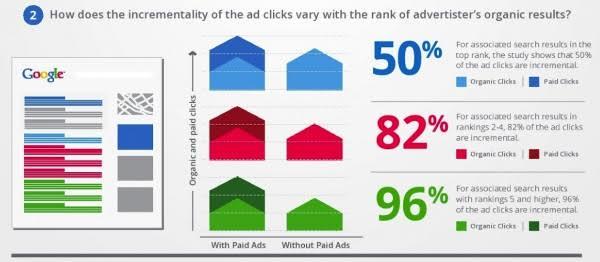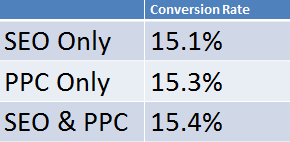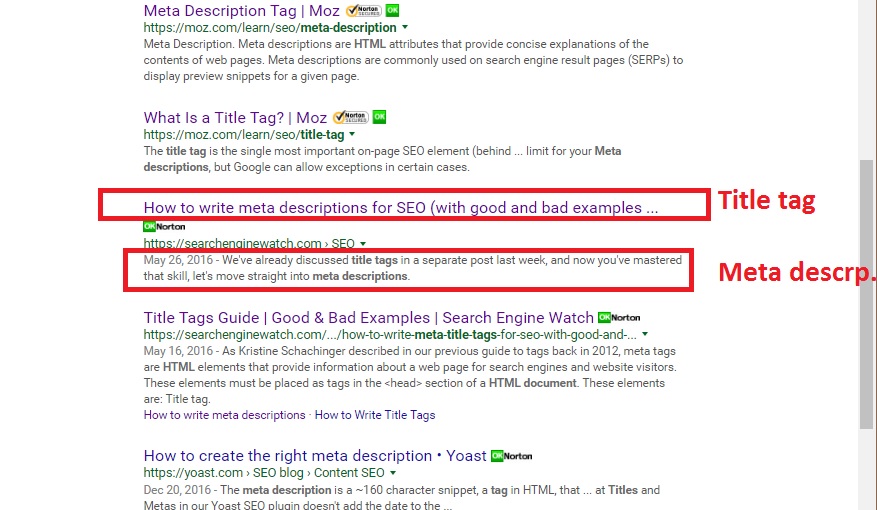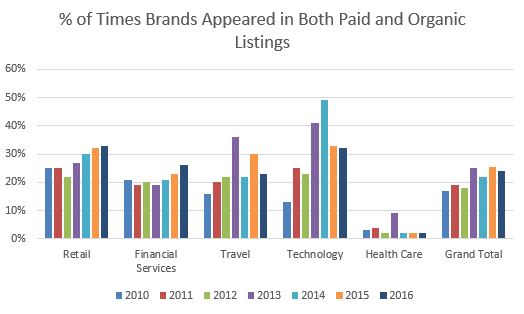PPC vs SEO: Why They Work Better Together
When marketers even suggest combining SEO and PPC campaign strategies, people cower in fear. “It’s a drain on resources! We’re overextending ourselves! We’re going to lose our organic traffic thanks to PPC ads!” All are common and somewhat understandable responses. The idea of putting organic and paid search strategies into the same hat might seem like a risky proposition, but the data is in and it suggests otherwise.
A 2012 study by Google shows a significant, and unmistakable correlation between the implementation of a synergized search strategy and positive ROI. We’re not just talking about the top 5 ranked sites on a SERP, we’re talking about everybody.
PPC vs. SEO – The Results Are In
Google has concluded that when a website ranks #1 on organic AND paid search resuls, 50% of their ad clicks are incremental. Meaning that in the absence of the ad, the site isn’t able to replace those paid clicks with more organic clicks, it just loses 50% of its PPC traffic.
As you can see in the table below, this percentage skyrockets as we move up the search engine rankings. If you’re ranked between 2-4 you lose 82% of those clicks, and if you’re 5-above? Forget it. 96% of your traffic is bye bye.
Remarkably, the ROI you can generate from a combined PPC and SEO plan outweighs the cost of ads on its own.
This says more about search synergy than many of us previously believed. For example, it wasn’t common knowledge that a site who was #1 on a search engine results page (SERP) would rely so heavily on paid ad traffic—and without that ad, they would not get their clicks replaced by organic traffic.
What this really tells us is that synergy dynamically improves the overall growth of a brand. The goal for most marketers then is to take the idea of combining organic and paid search strategies and apply it to existing campaigns. Easier said than done, of course.
What PPC + SEO Means For Marketers
Instead of building organic and paid search campaigns independently, it’s important for SEO and PPC marketers to get on the same page, creating campaigns that are inspired by a specific set of branded and non-branded terms.
As we’ve seen from Google’s study, the question is no longer, “should I bid on a keyword if I rank organically for that term?” This has been answered with an emphatic ‘YES!’ It’s also been confirmed by Brad Geddes of Search Engine Land, who ran experiments with companies who bid on their top branded organic keywords. On average, there was an increase in the overall conversion rate when SEO and PPC worked together versus when they ran independently of each other.
The question now is, “how do I achieve my brand’s SEO and PPC synergy?” The answer of course will vary from brand to brand, but we first want to start by getting our ducks in order. Let’s explore the similarities in SEO and SEM to help us inform our strategy going forward.
SEO and SEM Similarities
Running SEO and PPC campaigns in tandem can seem like a headache waiting to happen. There’s double the data to analyze, which oftentimes means double the changes to be made. However, if you try to focus on the similarities between SEO and SEM in general, it could help you streamline the process and provide you with more actionable results.
Here are some common ground areas to keep in mind.
- Keyword Research
Whether a piece of search engine content is paid or organic, you know it required a significant amount of keyword research to land it in front of a user’s eyes. When your goal is synergy, you have test a variety of keywords in both campaign settings. The idea is that you need to use the results from one campaign to inform your optimization efforts of the other.
For example, let’s say that non-branded keywords are performing better than branded terms in PPC. This wouldn’t be the news that any of us want to hear, but let’s say it’s true. It could be indicative of a larger branding problem. On the SEO side we’d take these struggling terms and examine all of our on-site content to ensure they are being correctly utilized. In many cases it could be as simple as poor formatting or lack of site authority. We could attempt to build brand awareness through better social media outreach, or by developing an infographic that sites could backlink to.
On a more basic level, we can run SEO and PPC campaigns simultaneously to determine whether users are searching our brand terms more often than our competitions’.
- Sales Funnel
Leading consumers through a sales funnel and towards a conversion is a definite team effort. A properly integrated campaign requires the sharing of search query data from the paid side in order to provide sufficient SEO insight on the organic.
At the top of the funnel, SEOs will look for broad, generic keywords that a visitor might be researching but has not gotten any more specific with yet. The SEO will gather this data based on the search query analysis of the PPC campaign, and use it to inform their on-site content and brand optimization decisions.
Mid-funnel, keywords begin to assume greater specificity. At this stage, PPC campaigns share vital keyword click and impression data to help the SEO campaign weed out the not-so effective keywords and start pushing the potential winners.
Near the end of the funnel, PPC conversion data can be analyzed and used to apply final changes to the SEO campaign. The goal here is to identify keywords that resulted in conversions and increased ROI. Those keywords assume a greater value than the rest (tier 1) and the SEO campaign needs to ensure they are being properly implemented on the website and are part of the overall brand content strategy.
Connecting the SEO and SEM campaigns all the way through a sales funnel demands constant reevaluation according to conversion data, search query data, and keyword information. This leads to a slew of changes in on-site content from the SEO standpoint, and potentially new bidding strategies for the PPC.
- Copywriting
From article headlines to title tags and beyond, effective copywriting means everything to an SEM campaign, and it’s pretty darn important for SEOs too.
An SEO campaign isn’t about infusing keywords all over the site, it’s about invoking a searcher’s need to click. When a web page is listed in Google’s search, it displays a title tag and a meta description.
These need to be treated like free advertisements, much like a PPC campaign. It is roughly 150-160 characters for you to sell your site to the searcher. And the best part? You don’t have to bid a penny for it.
When editing your title tag and meta description within your HTML code, or on WordPress using the Yoast SEO plugin, focus on ways to incorporate keywords while also encouraging people to click.
Your title should do more than just summarize what’s on the page. Similar to PPC ads, it should include a reasonable call-to-action, without going the clickbait route of course.
- Increasing Traffic
The goal of any SEO and PPC strategy is to increase traffic. How they accomplish that feat differs slightly.
While both strategies aim to conquer search engines, an SEO campaign procures traffic through other means. One convention that is currently the top signal for Google’s search algorithm, is backlinking.
Backlinking is the process by which other sites direct hyperlinks to your pages, which boosts your site’s authority and reputability in the eyes of Google. Like an effective PPC campaign that continually delivers good spend, good backlinking efforts can put your site in autopilot. When you produce engaging content, the number of people linking to it will increase.
- Search Engine Placement
It’s all about placing. This is probably the biggest commonality between SEO and PPC because both strategies dictate where your site shows up on SERPs. The advantage to PPC is that you never have to appease Google’s algorithm by making changes on your webpages. The disadvantage to PPC is that you have to pay to place, which can get expensive when bidding on competitive keywords.
SEO is all about placement too, but rather than dictating that placement through a dollar amount, you have to do so through various kinds of on-site and off-site optimization efforts.
- Analytics
Lastly, both methods require a proper study of analytics so that actionable changes can be made. Google Analytics can tell you a lot of the story especially with regards to PPC campaigns. For SEO analytics, there’s Screaming Frog, Moz, WooRank, and Google Keyword Planner.
Search Engine Marketing + SEO Success Stories
- Sky News
The English news agency was looking for a way to drive more traffic to their website for breaking news stories, using PPC. They enlisted the help of a solutions agency who took Sky’s RSS feed and ran it through system that automatically generated keywords that were relevant to particular news stories.
As soon as the stories broke, campaigns would be created using a fixed PPC budget. This, in tandem with write-ups on stories that utilized good SEO, gave Sky News 400% more page impressions than any of their non-breaking news campaigns.
- Jason Tabeling
Jason Tabeling is a digital marketing expert and Senior Vice President at Brandmuscle. Each year, he’s penned an article to Search Engine Watch chronicling the latest updates and changes to SEO/PPC synergy.
A strong advocate of the combined strategy for the past seven years, Tabeling noticed a significant alteration to it in 2016. This was the first time ever that mobile searches on Google exceeded desktop, and Google responded with a slew of changes to their mobile ad placements.
Because Google added an additional PPC ad above the organic search results on SERPs, Tabeling theorized it would be harder to synergize since lower-ranked organic sites would lose their spot. He was right, in theory.
But looking at this graph we see that brands are still managing to appear in both paid and organic listings a relatively high amount of times, especially when compared to 3-5 years ago.
Finding SEO & PPC Harmony
So yeah, SEO and PPC have a lot in common, making it 100% understandable why they function so well in synergy. But how do we reach that elusive point of synergy?
First, recognize that users exist across a broad swath of channels. And that’s okay. The key lies in reaching out to the right channels for your business. Start by mapping out a plan that meets your site’s goals, then establish KPIs to help you get there.
Many SEM experts suggest starting out with PPC before integrating SEO campaigns. It makes sense. SEO is like building a house, or in some cases a skyscraper. Lots of time needs to be dedicated to building layer after layer, i.e. producing page after page of high-quality, engaging content that will get shared. A PPC campaign can be created in minutes and start bringing in some initial traffic to get the ball rolling. As the brand grows, SEO and PPC campaigns will become more intertwined. Keyword research will improve as analytics emerge based on traffic, revenue, and conversion rates.
The takeaway here? Be patient and focus on nailing the construction process. Without that, your house will crumble before you even get to move in.







